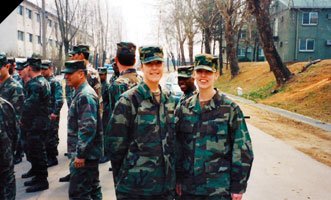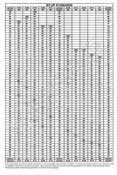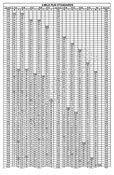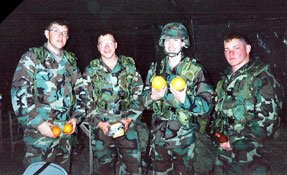As summer fast approaches, some of you may be preparing for military boot camp. Some may simply be bored with their current training program and are looking for something new. Others may want to take their training outdoors as the weather warms up.
Whatever the reason, you can be your own 'Army of One' by following this military-style training program. As a former Army active-duty soldier, I spent four years training myself and training other soldiers to get in shape and stay in shape according to the Army's standards.
If you're looking for a challenging, yet fun and fresh approach to training, I suggest you try training like a soldier!

The U.S. Army Physical Fitness Program

The Army's Physical Fitness Program revolves around the Army Physical Fitness Test (APFT) and its three components - push-ups, sit-ups and a 2-mile run. Soldiers are required to perform as many push-ups as they can in 2 minutes to test the muscular strength and endurance of the chest, shoulder, and triceps muscles.
They are then required to execute as many sit-ups as they can in 2 minutes to test the strength and endurance of the abdominals and hip flexors. Finally, soldiers must run a 2-mile course to test their cardiovascular endurance. Testing frequency varies, but soldiers are tested twice a year (every 6 months) at a minimum.
Between testing, Army leadership must develop and conduct group training sessions to ensure the soldiers are reaching and maintaining their physical fitness levels year-round. This is to ensure that the soldiers are physically ready at any time for the demands of the military during both times of war and peace.
While it's at the discretion of the leadership what type of program the subordinates follow, the Army physical fitness guidelines are outlined in Field Manual 21-20.

Strength Training

Because Army soldiers train in such large groups and are limited to facilities and equipment, most training sessions are conducted outdoors with little to no additional equipment. Basic bodyweight movements are the basis of the strength training workouts and are often conducted in circuit-style training.
The goal of all training sessions is to reach "muscle failure," much like the term bodybuilders use when taking a set "to failure." This means to completely exhaust the muscle so that it physically cannot perform another repetition of an exercise.
Intensity is the name of the game during these training sessions, and Army leaders are swarming around like flies just jumping at the chance to drill you for not giving 110%.

Cardiovascular Training

Either at the end of the strength workout or on opposing days the unit will conduct group runs of anywhere from 2-6 miles or more. These are usually in the form of steady state cardio, but sometimes interval training is incorporated through sprinting and changes in incline and pace.
Sometimes soldiers are broken down into "ability groups" based on the time range that an individual performs the 2-mile run. This lets leadership more effectively train the faster runners to stay fast and the slower runners to run faster. Basically, the individual soldier gets a more customized workout.

Training Split

Army training sessions are conducted for one hour, five days a week (Monday through Friday). Most units divide their training splits similar to the following way:
Monday
- - Cardio - Group Run (2-3 miles)
Tuesday
- - Strength Training - Muscle Failure (full- or upper body)
Wednesday
- - Cardio - Group Run (2-3 miles) or Sports Day*
Thursday
- - Strength Training - Muscle Failure (full- or upper-body)
Friday
- - Cardio - Unit Run (4-6 miles) or Road March
*During the warmer months, some units conduct a Sports Day once per week where they conduct group athletics, such as Frisbee football, handball or soccer. This is good for morale and camaraderie and gives the soldiers a break from their traditional training program.
Individual training sessions are broken down as follows:
Warm-up:
- 5-10 minutes of light calisthenics and stretching
Training Session:
- 30-50 minutes of strength training and cardio or just cardio
Cool-down:
- 5-10 minutes of stretching

Sample Program

When designing your own program, remember to stay to the basics, keep the intensity high and change your program frequently to continue challenging yourself and to keep your motivation high. Outlined below is a sample Army training program for you to follow. *
Monday - Run (Interval Cardio)
Warm-Up: 5 minutes of light calisthenics, such as jumping jacks, jumping rope, and/or jogging in place followed by 5 minutes of full body stretching.
Be sure to include the following muscle groups in your stretching:
- Shoulders
- Biceps
- Triceps
- Back
- Chest
- Abs
- Thighs
- Hamstrings
- Calves
- Hip flexors
Training Session: (33 minutes)
- 5 minutes jogging at moderate pace
- 2 minutes running at fast pace
- 5 minutes jogging at moderate pace
- 2 minutes running at fast pace
- 5 minutes jogging at moderate pace
- 2 minutes running at fast pace
- 5 minutes jogging at moderate pace
- 2 minutes running at fast pace
- 5 minutes jogging at moderate pace
Cool-Down: 5 minutes walking at slow to moderate pace followed by 5 minutes of full-body stretching.
Tuesday - Muscle Failure (Strength Training)
Warm-Up: 5 minutes of light calisthenics, such as jumping jacks, jumping rope and/or jogging in place followed by 5 minutes of full-body stretching.
Be sure to include the following muscle groups in your stretching:
- Shoulders
- Biceps
- Triceps
- Back
- Chest
- Abs
- Thighs
- Hamstrings
- Calves
- Hip flexors
Training Session: (~30 minutes)
For each of the following exercises, perform as many as you can non-stop with proper form, then immediately go into the next exercise.
- Regular Push-Ups
- 50 Jumping Jacks
- 25 Bent-Knee Crunches
- "Diamond" Push-Ups
- 50 Jumping Jacks
- 25 Reverse Crunches
- Wide-Arm Push-Ups
- 50 Jumping Jacks
- 25 Bruce Lee Sit-Ups
Perform the complete circuit one time, jog in place and/or stretch for 2 minutes, and repeat circuit an additional 2 times.
Cool-Down: 5 minutes of light calisthenics followed by 5 minutes of full-body stretching.
Wednesday - Sports Day
Warm-Up: 5 minutes of light calisthenics, such as jumping jacks, jumping rope and/or jogging in place followed by 5 minutes of full-body stretching.
Be sure to include the following muscle groups in your stretching:
- Shoulders
- Biceps
- Triceps
- Back
- Chest
- Abs
- Thighs
- Hamstrings
- Calves
- Hip flexors
Training Session: Choose a favorite individual sport that involves a high intensity. You may also opt to participate in an aerobics class or do a workout tape. Session should last at least 45 minutes, minus warm-up and cool down.
Cool-Down: 5 minutes of light calisthenics followed by 5 minutes of full-body stretching.
Thursday - Muscle Failure & Run
Warm-Up: 5 minutes of light calisthenics, such as jumping jacks, jumping rope and/or jogging in place followed by 5 minutes of full body stretching.
Be sure to include the following muscle groups in your stretching:
- Shoulders
- Biceps
- Triceps
- Back
- Chest
- Abs
- Thighs
- Hamstrings
- Calves
- Hip flexors
Training Session: (~30 minutes)
Perform each of the following exercises for the 2 minutes. Once you reach failure, drop to your knees, but make sure to KEEP MOVING for the entire two minutes! Rest 1-2 minutes, then move on to the next exercise. This is where a stopwatch and/or training partner come in handy.
- Regular Push-Ups
- Regular Sit-Ups
- Elevated Push-Ups (If in the gym, elevate feet on a bench or exercise ball. If outside, have a partner hold your feet or use any object in your environment, such as a tree stump or log.)
- Rocky Sit-Ups (On the positive portion of this exercise, cross your right elbow to your left knee, then your left elbow to your right knee before finishing the movement with both elbows on either side of your knees. This is a 3-count exercise (i.e. rock left, rock right, sit up)
Repeat entire sequence one time. Follow this strength training workout with a 1-mile jog at a moderate, steady state pace.
Cool-Down: 5 minutes of light calisthenics followed by 5 minutes of full-body stretching.
Friday - Road March
Equipment: For this simulated Road March, you will need a large, comfortable backpack. Fill the backpack with the desired number of "weight" for resistance. Typical loads for soldiers range from 25-40 pounds. Elite soldiers, such as Army Rangers and Special Forces, often march with 60-100 pounds in their rucksacks. Try on your backpack and check for comfort and mobility.
Be sure to wear loose-fitting, comfortable clothing, like a cotton t-shirt, to prevent chafing on the underarms, obliques and low back. Wear comfortable, thin, moisture-absorbing socks to prevent blistering. Wear a comfortable pair of cross-trainers that are not too tight.
The road march can be done anywhere, but it's more fun and realistic done on a hiking trail or in a park.
Warm-Up: 5 minutes of light calisthenics, such as jumping jacks, jumping rope and/or jogging in place followed by 5 minutes of full body stretching.
Be sure to include the following muscle groups in your stretching:
- Shoulders
- Biceps
- Triceps
- Back
- Chest
- Abs
- Thighs
- Hamstrings
- Calves
- Hip flexors
Training Session: (1 hour or 4 miles)
Typical Army road marches are conducted for long distances of around 4 miles, on average. Running and/or jogging are not allowed, so make sure to walk as fast as you possibly can and to keep a quick and steady pace. Carry a bottle of water with you to ensure hydration, and pack some carbohydrate snacks, such as fruit, in your backpack to consume immediately post-road march.
Cool-Down: 5 minutes of full-body stretching.
*Army physical fitness programs like the one outlined above are physically demanding. New soldiers are immediately thrown into an intense training program such as this to get them into top physical shape as quickly as possible. This often results in injuries to the soldiers who didn't attain proper fitness levels beforehand.
If you are just beginning this program, it is advisable to start with only half the intensity (number of exercises, length of runs/training sessions) and build up your fitness levels before resuming the full program.

Test Yourself

To see if you've got what it takes to be a U.S. Soldier, you can perform your own Army PT test periodically to see how you rank in comparison to the Army's standards.
Equipment
You will need the following items to conduct the test:
- Training Partner (To count your reps and hold your feet during sit-ups)
- Stopwatch (To time you during the push-ups, sit-ups, and 2-mile run)
- Comfortable workout clothing and a good pair of running shoes
- Marked 2-mile course (8-lap track at a football field is the best option)
Conduct The Test
Event 1: Push-Up
Get down on your hands and knees to prepare for the push-up event. Have your training partner kneel at your side with stopwatch in hand. Your partner should announce "Ready, begin" and start the stopwatch for 2 minutes.
The trainee should assume the push-up position on the word "ready" and immediately begin doing as many push-ups as possible when the trainer says "begin." The trainee may rest with the knees bent and the buttocks in the air, but at no time may he/she move his/her hands or feet off the ground.
This results in disqualification. The trainee must resume the proper push-up position prior to resuming repetitions. If form is broken the trainer must not count that push-up as a repetition. The final number of push-ups after 2 minutes will be written down as the push-up raw score (i.e. 54).
Trainee may rest up to 10 minutes between events 1 and 2.
Event 2: Sit-Up
Assume the sit-up position by lying on the ground with knees bent at a 90-degree angle, feet flat on the ground and arms behind the head with fingers interlocked. Your partner should hold your feet with his hands only, and announce "Ready, begin" and start the stopwatch for 2 minutes.
At no time during the test can the trainee unlace the fingers, or that repetition will not count and the trainee will be disqualified. You may not raise his/her hips off the ground in an effort to use momentum to perform additional sit-ups. You must sit up high enough so that the shoulder blades are in line with the hips and create a perpendicular line with the ground for that repetition to count.
You may rest in the upright position, but if you rest on the ground for more than several seconds without making a continuous effort to sit up, you will be disqualified. Perform as many sit-ups as you can for the entire two minutes. The final number of sit-ups after 2 minutes will be written down as the sit-up raw score (i.e. 68).
Trainee may rest up to 10 minutes between events 2-and-3.
Event 3: 2-Mile Run
The run will be conducted on a marked 2-mile course that is a relatively flat course. Your partner should announce "Ready, begin" and start the stopwatch. You should immediately begin running at a pace that you can maintain for the 2-mile duration of the run.
Each time you complete one lap, the trainer should call out your time loud enough for you to hear. This helps you gauge your pace so that you can speed up to make time if necessary.
You may walk during the run, but it is not advised as it will likely be detrimental to you passing the test. When you complete the 2-mile course, the trainer will stop the stopwatch and write down the exact time of completion.
Scoring
The scores from each of the three events will be compared with the scorecard chart to determine how many points you received for your score in each event. The chart is based on age and gender. To determine your score for each of the events, take the initial raw score for that event (i.e. 54 push-ups) and find that number in the left-hand column of the chart.
Scroll over until you are in your age group and gender to determine the number of points for that event. (A 23-year-old male who performed 54 push-ups would have a score of 77 points out of a possible 100.) Score each event in this fashion, then add the number of points from all three event together to determine your final score out of 300 possible points.
The U.S. Army requires soldiers to score a minimum of 60 points in each event (180 points total) to maintain a passing score. If determined by the unit's command, a soldier scoring the minimum points is usually required to perform additional remedial physical training to better his/her fitness level.
A soldier who scores at least 90 points in each event (270 points total) will receive the U.S. Army Physical Fitness Excellence Award for achieving and maintaining outstanding physical fitness levels.

Supplementary Nutrition

Army soldiers are supplied with a wide variety of nutritious food to fuel them for training sessions and soldierly duties. This is great for energy, but not so great if you are trying to burn body fat and shed a few pounds. As with any training program, proper nutrition is vital in attaining your goals.
While I was on active duty, I ate fairly clean and sensibly yet still ate enough to provide adequate energy for my Army training. Here are a few guidelines you can use to develop a sound supplementary nutrition plan:
- Eat frequent, small meals every 3-5 hours to keep your body constantly fueled and your metabolism buzzing like a HumVee.
- Drink 2-3 liters of water a day to stay hydrated for your training sessions, especially if they are being conducted outdoors and in the summer heat.
- Comprise your meals of lean protein sources, fresh vegetables, and healthy fats to ensure your body's getting all of the nutrients and vitamins it needs to fuel your training sessions.
- Have one cheat day per week and allow yourself to eat whatever you want. This helps keep you motivated to stick to your diet in the long run, and is a good reward for all the hard work you've been doing.
Now that you know the basics, get out there and TRAIN LIKE A SOLDIER!!! HOOAH!
Good Luck!





